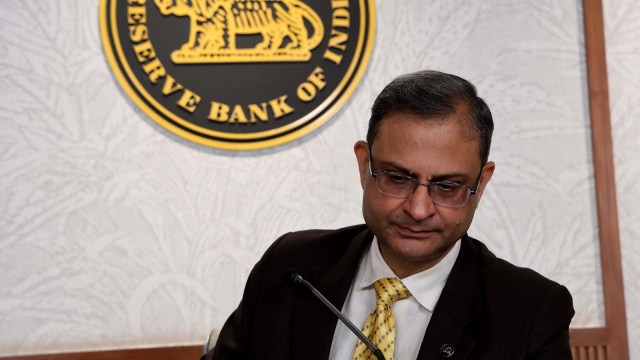RBI allows banks to fund M&As, lend in rupee to residents of India’s neighbours
To give primary markets a boost, limit on loan against shares raised to Rs 1 crore from Rs 25 lakh.
 Reserve Bank of India Governor Sanjay Malhotra in Mumbai on Wednesday. (Express photo by Ganesh Shirsekar)
Reserve Bank of India Governor Sanjay Malhotra in Mumbai on Wednesday. (Express photo by Ganesh Shirsekar)AT A TIME when India is grappling with rising trade frictions with the US and President Donald Trump’s sharp rhetoric against a BRICS currency, the Reserve Bank of India (RBI) on Wednesday unveiled a series of measures to deepen the financial markets, allow banks a greater role in corporate consolidation, and crucially, take steps towards internationalising the rupee.
The package includes two breakthrough decisions. First, banks will be allowed to finance corporate takeovers — a domain from which they were long barred. Second, Indian banks and their overseas branches can begin extending rupee-denominated loans to residents of neighbouring countries such as Nepal, Bhutan, and Sri Lanka. Both steps mark a strategic shift in how the RBI envisions India’s financial system: no longer inward-looking, but geared towards building regional and eventually global influence.
These new measures were announced by RBI Governor Sanjay Malhotra along with the interest rate decisions. The RBI Wednesday kept the repo rate unchanged at 5.5 per cent and monetary policy stance ‘neutral’.
In what could also boost the primary markets, the RBI proposed increasing the lending limit for IPO financing to Rs 25 lakh from Rs 10 lakh, and also raised the limit on loan against shares to Rs 1 crore from Rs 20 lakh now. The last revision on loan against shares was made in 1998, and the Governor said the banks’ risk-handling capacity has increased over time. The central bank has also proposed doing away with the ceiling on lending against listed debt securities.
The RBI’s most striking move lies in its fresh push to globalise the rupee. It has decided to allow authorised dealer banks in India, and their overseas arms, to lend in rupees to residents and institutions in select neighbouring countries. Analysts see this as the beginning of a larger effort to position the rupee as a credible alternative for trade and settlement in the region. By providing liquidity to neighbouring economies, India aims to wean them away from dollar dependence in their dealings with India, while simultaneously building confidence in the rupee’s stability.
The geopolitical context is critical. Over the weekend, President Trump warned BRICS nations — Brazil, Russia, India, China and South Africa — that they would face 100 per cent import tariffs if they attempted to launch a joint currency or support another one to rival the US dollar. Though Russia has denied any immediate plan for a BRICS currency, the debate has rattled global financial markets. Against this backdrop, the RBI strategy is clear: if India cannot dictate terms at the level of a new reserve currency, it can at least start by carving out regional dominance for the rupee.
The RBI also highlighted its gradual liberalisation of foreign exchange regulations under the Foreign Exchange Management Act (FEMA). Trade settlement in local currencies is already underway, but without accessible rupee liquidity abroad, the experiment remained limited. The new steps, the central bank said, are meant to correct that gap.
Another reform aimed at strengthening the rupee’s global credibility involves expanding the list of currencies benchmarked by the Financial Benchmarks India Limited (FBIL). So far, only the US dollar, euro, pound and yen were covered. With more trading partner currencies to be added, banks will be encouraged to directly quote a wider set of forex pairs. This will reduce the inefficiencies of routing trades through the dollar, deepen the rupee market, and gradually build its stature as a trading and settlement unit.
Equally significant is the RBI’s decision to allow surplus balances in Special Rupee Vostro Accounts (SRVAs) to be invested in corporate bonds and commercial papers. SRVAs, introduced in 2022, permitted invoicing and settlement of trade in rupees. Until now, idle balances could only be parked in government securities. Opening this window to corporate debt instruments not only gives foreign participants more options but also boosts liquidity in India’s corporate bond market.
Together, these steps form part of a deliberate plan: to make the rupee a settlement and investment currency of choice in India’s extended neighbourhood, while laying the groundwork for its eventual acceptance on a broader stage.
Banks to enter the takeover game
The other headline reform is the RBI’s decision to allow banks to finance corporate acquisitions, an area considered to be risky so far. For decades, Indian banks were prohibited from lending directly for takeovers, on fears that promoters might misuse borrowed funds to wrest control of companies instead of deploying them for productive growth. There were exceptions in some cases, particularly for acquisitions linked to insolvency proceedings under the Insolvency and Bankruptcy Code (IBC).
As a result, takeover financing had been dominated by non-banking financial companies (NBFCs), bond issuances or markets. Large firms often had to depend on the market or complex share swaps to stitch together deals. This made the process cumbersome and limited the pace at which Indian corporates could consolidate or expand through mergers and acquisitions.
By bringing banks into the picture, the RBI is unlocking an entirely new financing channel for corporate India. With their deeper balance sheets and lower cost of funds compared to NBFCs or private funds, banks can provide large, structured loans to firms pursuing strategic acquisitions. Analysts believe this will allow Indian companies, particularly stronger and well-managed ones, to scale up operations, build competitiveness, and accelerate capital expenditure.
RBI Governor Sanjay Malhotra said the aim will be to promote stability, while at the same time improving competitiveness, encouraging and enhancing growth of the economy.
The reform is also a direct response to persistent lobbying from the banking sector. Lenders have long argued that financing acquisition of established, listed companies is no more risky than lending for large projects. By tapping this segment, banks can diversify their loan books, generate higher yields, and play a bigger role in corporate growth stories.
At the same time, the RBI has been cautious to stress that this framework will come with safeguards. The enabling structure will balance growth imperatives with risk controls, ensuring funds are not misapplied. This shift reflects the central bank’s willingness to evolve from its historically conservative stance into one more aligned with the needs of a rapidly growing economy.
The RBI has also proposed scrapping the 2016 framework that discouraged banks from lending to large borrowers with credit limits of Rs 10,000 crore and above. It said credit concentration risks at the individual bank level are already addressed under the Large Exposure Framework, while system-wide risks, if needed, will be managed through macro-prudential tools.
Taken together, these reforms mark a turning point. The RBI is opening doors that were previously bolted shut: it is letting banks into the heart of corporate India’s consolidation game, and it is pushing the rupee onto the regional stage. Neither move is without risk. Bank financing of takeovers can, if unchecked, fuel reckless borrowing and asset bubbles. Internationalisation of the rupee can expose India to sudden external shocks if confidence wavers.
But the larger message is clear. India’s central bank is signalling confidence in the economy’s resilience and its institutions’ ability to handle greater freedom. In a world where geopolitical pressures are intensifying, and the dominance of the US dollar is increasingly being questioned, the RBI is betting that India cannot afford to remain a bystander. It wants the rupee to travel, and Indian corporates to grow larger footprints. For the first time in years, the RBI’s reforms seem less about tinkering and more about ambition.







- 01
- 02
- 03
- 04
- 05
























